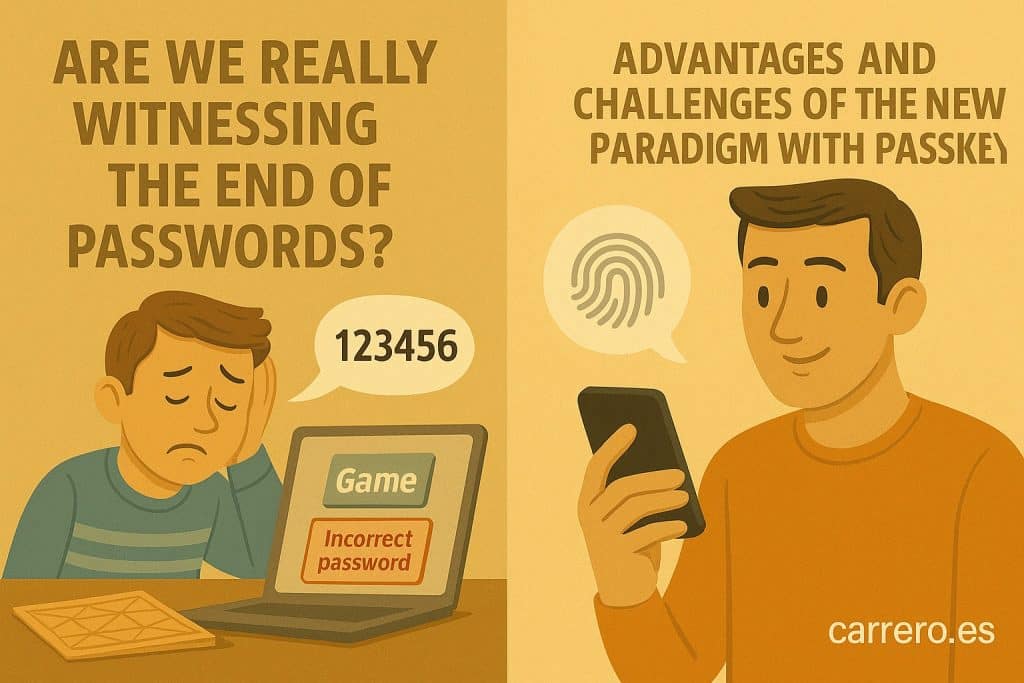We’ve all experienced it — the frustrating ordeal of trying to recall a password. That mix of annoyance, insecurity, and wasted time when a system replies with the dreaded “incorrect password” despite being sure you typed it right. After years of being told to use complex combinations of uppercase letters, numbers, and symbols, we still fall back on classics like “123456” or “qwerty.” Clearly, something had to change.
And that change is taking shape through a technology that promises to solve many of these problems: passkeys. A new authentication method that is not only more secure and user-friendly but may also signal the definitive sunset of passwords as we know them.
What Are Passkeys and Why Are They Revolutionizing Digital Access?
A passkey is a unique cryptographic key stored locally on your device and used to authenticate your identity securely. No need to type or remember complex strings — simply use a biometric factor (fingerprint or facial recognition) or a PIN to log in.
The real innovation lies in how it works behind the scenes: instead of sending your password to a server, your device sends a signature generated using a private key that only it knows. The server then validates that signature using the corresponding public key. No sensitive data travels across the network or gets stored where it could be stolen.
Clear Advantages from the First Use
I’ve tested passkeys myself on services like Google, Amazon, and GitHub, and I can confidently say the experience is excellent. Some of the most noticeable benefits include:
- Faster logins: Sign-in is practically instant. You authenticate biometrically, and you’re in.
- More secure: With no passwords involved, common attack vectors like phishing or brute force become irrelevant.
- Device syncing: With tools like 1Password, Bitwarden, or Apple’s iCloud Keychain, your passkeys move with you, no memorization required.
- Protected privacy: Your biometric data never leaves your device. The website, server, or even the passkey provider can’t access it.
In many cases, passkeys even let you log in automatically if your device is already unlocked — transforming the user experience completely.
But Is This Really the End of Passwords?
Not so fast. As with any technological shift, adoption isn’t immediate or universal. While passkeys solve many problems, they also introduce new challenges:
- Uneven compatibility: Not every service supports passkeys yet. Many still require a username and password.
- Shared or outdated devices: In settings like libraries, shared computers, or old terminals, passkeys aren’t always feasible.
- Shared accounts: Passkeys are personal, making them harder to use for family or collaborative accounts.
- Device loss scenarios: While encrypted cloud backups exist, not all users have them configured, leading to potential lockouts.
- Enterprise and legacy systems: Many businesses rely on old infrastructure, VPNs, or tools incompatible with modern authentication like passkeys.
A Necessary (and Welcome) Transition
Despite these caveats, the direction is clear: passkeys represent a significant evolution in digital security. They merge the best of passwords and two-factor authentication into a smoother, safer, and more intuitive experience.
Personally, I deeply value the balance between usability and security that passkeys offer. Yes, we’ll still live with legacy systems requiring passwords for some time. But this new approach clearly marks a turning point. In a few years, we may look at passwords the same way we view floppy disks today — once necessary, but ultimately replaced by better, more user-friendly technologies.
What Now?
My advice is simple: start testing them. Enable passkeys on your main accounts — especially those that already support them. Get familiar with how they work, how they sync across devices, and whether your preferred password manager supports them.
The future of digital access is being built today, and passkeys are undoubtedly a cornerstone of that landscape. Just don’t forget to maintain a solid password manager for those services where passkeys are not yet an option — each account should still have a unique and strong password where needed.
—
Author: David Carrero Fernández-Baillo. Spanish edition here.

